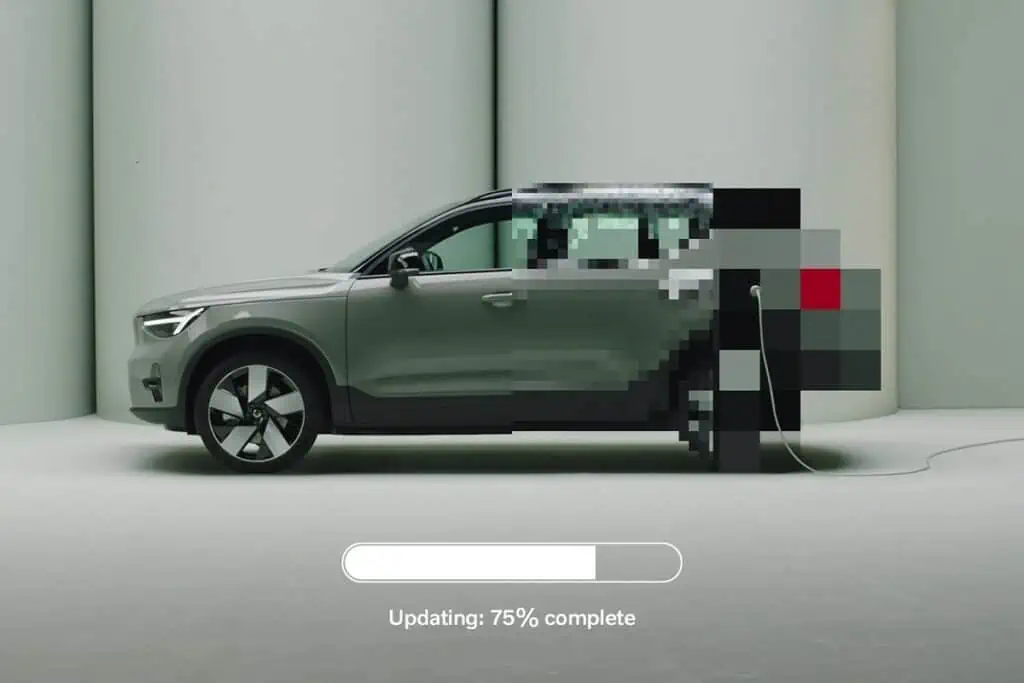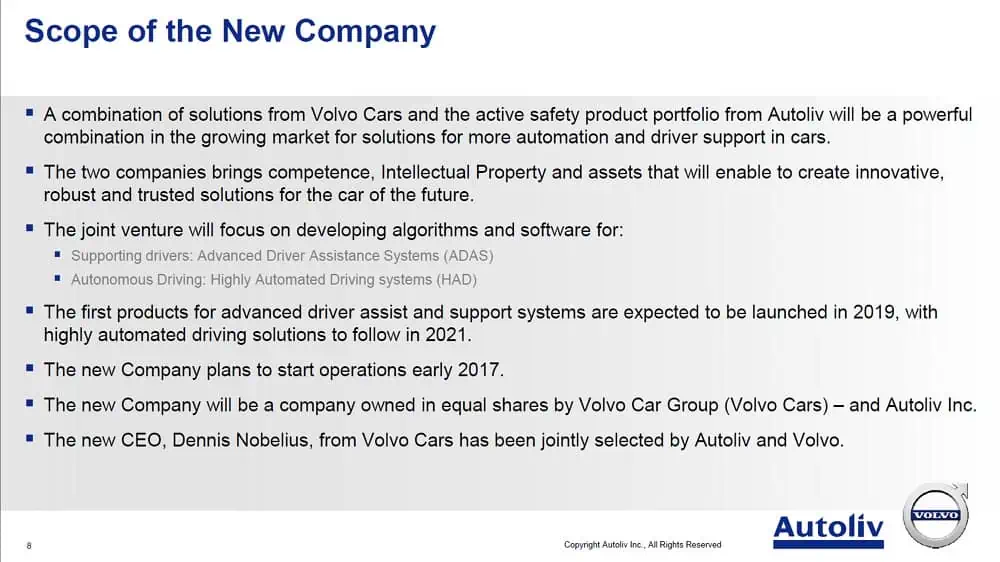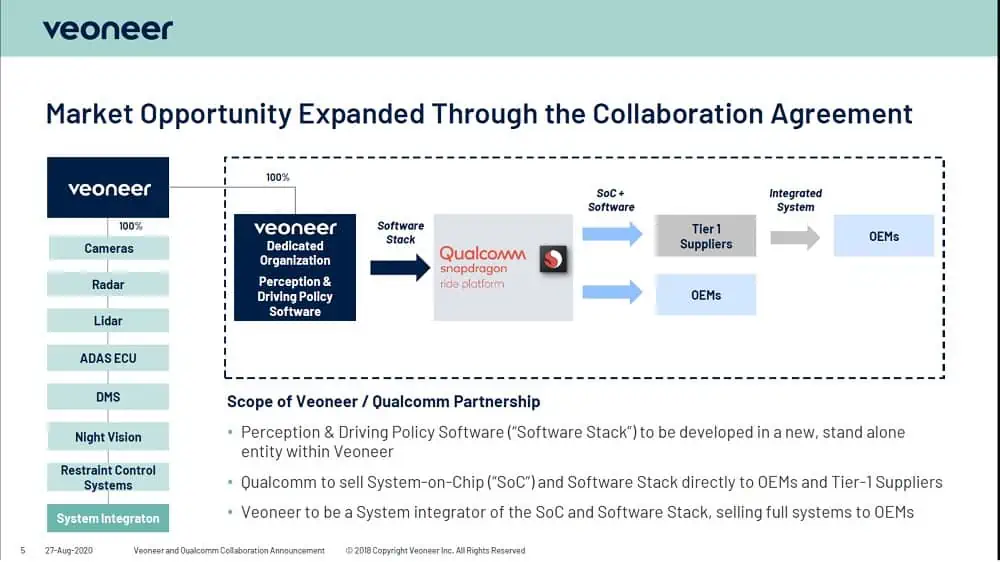
XC40 Recharge updated over-the-air (Image: Volvo)
By Colin Barnden
What’s at stake?
Self-driving was supposed to mean jumping into your car, hitting the “self-drive” button and falling asleep or watching a movie while your car chauffeured you safely to any destination. But the reality looks nothing at all like that.
In 2017 Volvo promised self-driving cars for sale by 2021. Like every automaker that made similar predictions, it didn’t work out. Let’s put together all the pieces of the puzzle to see what did happen.
Volvo’s lofty goal of autonomous driving was set out in an announcement entitled “Volvo Cars and Autoliv team up with Nvidia to develop advanced systems for self-driving cars,” where the automaker committed to “Level 4 autonomous cars for sale by 2021.” Hakan Samuelsson, president and chief executive of Volvo Cars, said:
This cooperation with Nvidia places Volvo Cars, Autoliv and Zenuity at the forefront of the fast-moving market to develop next-generation autonomous driving capabilities and will speed up the development of Volvo’s own commercially available autonomous drive cars.
The first solid announcement relating to the Volvo-Nvidia partnership was in October 2018, with a press announcement stating “Volvo Cars Selects Nvidia Drive AGX Xavier for Production Cars.” Volvo’s Samuelsson commented:
A successful launch of autonomous drive will require an enormous amount of computing power, as well as constant advances in artificial intelligence. Our agreement with Nvidia is an important piece of that puzzle and helps us to safely introduce fully autonomous Volvo cars to our customers.
Fast-forward to April 2021 and Volvo announced its self-driving platform would now feature both the Xavier SoC and Nvidia’s Orin, the successor to Xavier:
The Nvidia Drive Xavier-powered core computer will manage core functionalities inside the car such as base-software, energy management and driver assistance. It works together with the Nvidia Drive Orin-powered autonomous driving computer, which is dedicated to computing-intense work such as vision and LiDAR processing and delivering the high safety integrity level required for autonomous driving.
Almost four years after the original commitment to self-driving cars, Volvo had barely tied-down the processor specifications. This meant the promise of autonomous cars for sale by 2021 was going to be missed – by a mile.
Zen who?
Also named in Volvo’s 2017 self-driving announcement was an unknown entity called Zenuity, a joint venture software company formed between Volvo and Swedish tier one supplier Autoliv.

As shown above, Zenuity’s mission was to develop algorithms and software for both advanced driver assistance systems (ADAS) and autonomous driving.
In July 2018, Autoliv completed the spin-off of its electronics business into a new standalone company called Veoneer, which included Autoliv’s share of the intellectual property assets of Zenuity.
In October 2018, Veoneer announced Zeus, a high-performance domain controller intended to meet the needs of SAE Level 4 autonomous driving. Zeus was based on the Nvidia Drive Xavier SoC and would run Zenuity’s autonomous driving software stack.

So was formed a platform comprising hardware from Veoneer and Nvidia, with Zenuity’s autonomous driving stack, that would plausibly fulfill Volvo’s promises of self-driving cars by 2021.
The precise details of what happened next, we will never know for sure.
Amid the depths of the first wave of the coronavirus, a decision was made that will shape the automotive technology sector for at least the next decade.
In April 2020, it was announced that Veoneer and Volvo were to split the intellectual property assets of Zenuity:
Veoneer will integrate and operate the current Zenuity business focused on the development and commercialization of ADAS software for collaborative driving. Volvo Cars will setup a new stand-alone company to take over Zenuity’s current development and commercialization of unsupervised autonomous drive software.
Zenuity’s unsupervised autonomous drive software assets became the almost unknown entity called Zenseact. Volvo intends to use this software stack to power Ride Pilot, its proprietary driving system.
In comparison, the ADAS software for collaborative driving now goes by a rather more high-profile name.
Arriver arrives
In August 2020, Veoneer and Qualcomm stunned the tech industry by announcing a partnership to deliver scalable ADAS and collaborative driving solutions.
Veoneer had switched from partnering with Nvidia to partnering with Qualcomm.

The “Perception & Driving Policy Software” shown in the slide above – previously the ADAS software for collaborative driving – is today known as Arriver.
Qualcomm acquired Arriver in April 2022, having outbid Magna to secure the assets, for $4.6 billion
To paraphrase American entrepreneur Victor Kiam, Qualcomm liked the Arriver software so much, it bought the company.
The combination of Qualcomm’s SoCs with Arriver’s perception and driving policy software stack looks set to disrupt the established order in the automotive industry, which previously was moving inexorably towards a duopoly of supply between Mobileye and Nvidia.
In less than two years the Qualcomm-Arriver partnership has completely altered industry expectations. Most automakers now look to have abandoned entirely their plans for privately-owned autonomous passenger vehicles, with the focus instead on collaborative driving and supervised automation systems, such as GM Super Cruise and Ford BlueCruise.
BMW, a longtime Mobileye customer, was the first automaker to commit to Qualcomm-Arriver; Ferrari, Renault and Stellantis look to have followed suit and possibly also Ford.
With GM and Volkswagen also committed to using Qualcomm’s SoCs to run their proprietary software stacks for supervised automation systems, the design-win momentum now rests firmly with the San Diego company. Put simply, Qualcomm is eating Mobileye’s lunch.
Although Volvo has persevered with the development of an unsupervised autonomous driving system, it suddenly finds itself swimming against the industry tide. New Volvo CEO Jim Rowan will almost inevitably cancel the Nvidia-Zenseact Ride Pilot program – most likely before the end of the year.
In January Volvo committed to using Qualcomm’s cockpit applications processor to power its next-generation infotainment system. Therefore, the obvious logical next step would be for Volvo to follow the lead of other automakers and turn to the Qualcomm-Arriver partnership for automated driving.
In so doing, Volvo would end up paying to license the very intellectual property assets for ADAS and collaborative driving that it previously jointly owned in Zenuity.
Start with the customer experience
Privately-owned autonomous cars don’t exist – they aren’t even close. In an effort to prove its technology chops, Volvo disregarded “Steve’s Law,” named after Apple’s Steve Jobs. Speaking at Apple’s 1997 Worldwide Developer Conference, Steve explained:
You’ve got to start with the customer experience and work backwards to the technology. You can’t start with the technology and try to figure out where you are going to sell it.
In seeking to develop Ride Pilot’s “unsupervised autonomous driving” function, Volvo simply pursued the wrong customer experience. As highlighted by Consumer Reports:
Asked about advanced driving assistance systems such as lane centering assist, automatic lane changing, and driver monitoring, respondents said they wanted the features — but they also indicated that they wanted to remain engaged behind the wheel.
Translation: Car buyers want supervised automation systems like Ford’s BlueCruise, not unsupervised autonomous driving features like Volvo’s Ride Pilot.
With the F-150, Ford has been the manufacturer of the best-selling vehicle in the U.S. for the last 40 years and understands the importance of prioritizing the customer experience over technology. It already has Steve’s Law stitched into its corporate DNA.
For example, Ford’s conversion to an electric future unsurprisingly began with an electric version of its best-selling vehicle: the F-150 Lightning. The Lightning features innovative ideas such as an onboard mobile generator, a frunk (front trunk) providing over 14 cubic feet of storage, and the well-regarded BlueCruise system for hands-free operation on divided highways.
The Blue Oval understands that delighting the customer rarely depends on unproven, state-of-the-art technology. This is a lesson which Volvo, once owned by Ford, clearly hasn’t grasped.
Arriver cannot arrive soon enough at Volvo. When will new CEO Rowan hit the kill switch on Ride Pilot? Qualcomm’s first automotive investor day is scheduled for Sept. 22. Volvo, and possibly Ford, might take center stage making some big announcements, so we could know the answers then.
Bottom line:
Self-driving is a financial millstone hanging around the necks of automakers, the result of absurd promises and flashy partnerships with self-interested technology suppliers. The route to success for automakers in the coming decade is the same as it always was: Build great cars customers want to own and drive, with features they are willing to pay extra for.
Colin Barnden is principal analyst at Semicast Research. He can reached at [email protected].
Copyright permission/reprint service of a full TechSplicit story is available for promotional use on your website, marketing materials and social media promotions. Please send us an email at [email protected] for details.
